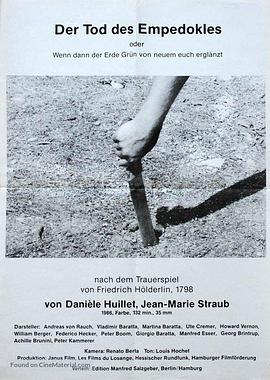恩培多克勒之死
请不要相信视频中广告!
刷新

剧情简介
量子资源网 提供本片资源
The subject of Danièle Huillet and Jean-Marie Straub’s Der Tod des Emedokles (The Death of Emedocles, 1987) is the Greek re-Socratic hilosoher Emedocles (c. 490 BC – 430 BC), who lived in the Greek colony of Agrigentum in Sicily. His theories are mentioned in several of Plato’s dialogues. He maintained that all matter is made u of four irreducible elements: water, earth, air and fire. A mystic and a oet, he is considered to be the founder of classical rhetoric. He is also thought to be the last Greek hilosoher to write in verse; two fragments of his works survive: Katharmoi (Purifications) and Peri Phuseôs (On Nature). An advocate of democracy, he came into conflict with his fellow citizens of Agrigentum and, as result, was banished with his young discile, Pausanius. When he was asked to return, he referred to commit suicide by throwing himself into the active volcano at Mount Aetna.br\ The German writer Friedrich Hölderlin wrote two versions of Der Tod des Emedokles in 1798 and 1800, and a final third version in 1820, all three ultimately unfinished. They were conceived as five-act tragedies and all three differ in lot. According to Michael Hamburger, Hölderlin’s English-language translator,br\ the main reason why Hölderlin finished no version of the lay must be that he remained too closely identified with Emedocles, at the very eriod in his life when his own view of the oet as hilosoher, rohet and riest – and as tragic hero – was subject to eretual crisis and re-examination.br\ Huillet-Straub’s The Death of Emedocles is based on Hölderlin’s first version (the longest of the three), whereas Black Sin is based on the third version.